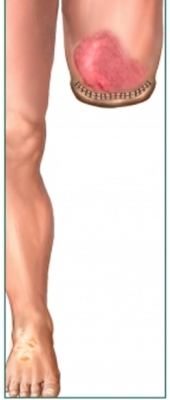Ablation – General information
Description amputation
Ablation – surgery to remove parts of the body. Removal is done because of illness or injury.

Indications for amputation
Ablation, usually, It is one of the following reasons::
- Peripheral arterial disease, calling:
- Gangrene;
- Incurable pain;
- Severe infections of soft tissue;
- Severe trauma, which can not be cured;
- Complications of diabetes;
- Incurable infection of the bone (osteomyelitis);
- Malignant tumor;
- Congenital deformity of the body;
- Severe frostbite;
- Complications of connective tissue (connective tissue diseases), such as:
- Lupus;
- Scleroderma.
Possible complications
If you plan to have surgery, you need to know about possible complications with amputation, which may include:
- Poor wound healing at the site of amputation, ending the need for a new amputation;
- The withering away of the skin;
- Infection;
- Bleeding;
- Swelling of the surgical site;
- Phantom pain – feeling pain in amputated limbs;
- Phantom sensation – feeling, that the amputated limb is in place;
- Blood clots;
- Complications from anesthesia.
Some factors, that may increase the risk of complications, include:
- Peripheral vascular disease;
- Diabetes;
- Infection;
- Prolonged immobility;
- Heart disease;
- Smoking or lung disease;
- Blood clotting;
- Taking certain medications (eg, Steroids).
How is an amputation?
Preparation for the procedure
Amputation may be planned in advance. In this case, the procedure and the consequences of a fairly predictable. Emergency amputation can be performed due to a sudden trauma or life-threatening infections. Here, the result can be different, until serious complications.
Depending on the location of the injury and, your doctor may do some tests before surgery:
- Roentgen – to take a picture of the body's organs, especially bones;
- COMPUTER tomography – X-ray examination, wherein the computer is used, to make pictures of body structures;
- MRT (magnetic resonance imaging) – analysis, which uses magnetic waves, to make pictures of organs inside the body;
- Analysis of the bones, to check for infection;
- Tissue Culture Assays;
- Blood tests;
- Evaluation of cardiac function;
- Appoint antibiotics;
- Assays, to assess blood flow in body parts, which amputated.
On the eve of the operation:
- It is necessary to prepare the conditions for the rehabilitation of the house after returning from the hospital;
- It is necessary to follow the instructions, do not take food for twelve hours before the operation;
- Maybe, it will be necessary to use antibacterial soap for several days prior to surgery.
Anesthesia
Anesthesia will depend on, which body part is operated:
- The operation is performed under general anesthesia, during the operation the patient is asleep;
- Local anesthesia – analgesia particular area or portion of the body;
- Spinalynaya anesthesia – analgesia lower body.
Procedure amputation
On the affected limb or limb incision. If necessary, cut off the muscles. The blood vessels are associated or isolated, to prevent bleeding. After these operations, cut off the bone. Sick or damaged body part is removed.
The muscles around the bones fit, they imposed the remaining skin and sutured, forming cults. In place of the operation is superimposed sterile dressing. When a serious infection of the place of amputation can be left open, to heal naturally.
Duration of operation
This procedure may take 20 minutes to several hours,. The duration will depend on the type of amputation.
Will it hurt?
Anesthesia will prevent pain during surgery. For pain relief after surgery appoint appropriate painkillers. There may be a phantom pain at the site of the amputated body. For their treatment should consult a doctor.
The time spent in hospital
The stay in the hospital will depend on the type of amputation. Usually stay:
- Amputation of the foot or toe: 2-7 days;
- Amputation Noggin: from 2 days before 2 weeks;
- Upper limb: 7-12 days;
- Amputation palytsa Ruki: 0-1 day.
If you experience complications during hospitalization can be extended.
Postoperative care
In the hospital
Following operations can be assigned to the following treatments:
- The limb is suspended, which helps to reduce swelling;
- Carry out the procedure for the prompt lifting his feet;
- A few days after the surgery appointed physiotherapy, aimed at increasing the mobility of;
- Sometimes fixing the limb impose plaster;
- They can be assigned to certain medications. It can be treated with antibiotics or blood thinners.
- Once the wound heals, the patient is fitted with a prosthesis.
Home Care
The stitches will be removed within a few weeks after surgery. Houses need to do the following, to ensure the normal recovery:
- You must quit smoking. Smoking can interfere with healing;
- Keep the place clean operation;
- Follow the instructions for the care of the prosthesis;
- You may have prokonsultikovatsya with a psychologist on the emotional state after amputation;
- Undergo regular inspection in hospital;
- Consult with your doctor about, what medicines to take home.
Besides, check with your doctor, when it is safe to shower, bath, place or subject to water amputation.
It is necessary to go to the hospital in cases
- There are signs of infection, including fever and chills;
- Redness, edema, uvelichivyuschayasya pain, bleeding or discharge from the incision site;
- Severe pain;
- Cough, shortness of breath or chest pain;
- Severe nausea and vomiting.
